|
|
|
Sort Order |
|
|
|
Items / Page
|
|
|
|
|
|
|
| Srl | Item |
| 1 |
ID:
135583
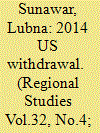

|
|
|
|
|
| Summary/Abstract |
The deployment of international troops in Afghanistan led by the US in 2001 brought new challenges for Pakistan to deal with. With American troops based in Afghanistan’s side of the border, the question of where the border was and Pakistan’s responsibilities for maintaining peace, law and order in its own territories acquired international attention. Militants were allegedly hiding on both sides of the border and were entering Pakistan through this porous border.
|
|
|
|
|
|
|
|
|
|
|
|
|
|
|
|
| 2 |
ID:
109887
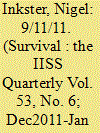

|
|
|
| 3 |
ID:
132511
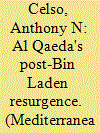

|
|
|
|
|
| Publication |
2014.
|
| Summary/Abstract |
The Barack Obama administration's May 2013 assessment of al Qaeda's weakness and fracturing in the post-bin Laden era has been greeted with indignation by both liberals and conservatives. They believe al Qaeda is stronger than ever in the wake of the Arab Spring. These critics, however, misunderstand the network's dysfunctional direction. Al Qaeda's "resurgence" is likely to lead to its failure. The argument proceeds on four levels: (1) the dramatic growth of the al Qaeda network masks its internal weakness and organizational splintering; (2) the Arab Spring has led to a burst of al Qaeda activism that is likely to undermine its jihadist cause; (3) al Qaeda's fragmentation and its multiple trajectories in the post-9/ 11 era violate bin Laden's original intent and are beyond al Qaeda Central's direction; and (4) the dysfunctional nature of al Qaeda's ideology and its excessive reliance on takfiri violence is paradoxically a source of both persistence and failure.
|
|
|
|
|
|
|
|
|
|
|
|
|
|
|
|
| 4 |
ID:
103423
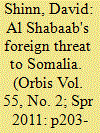

|
|
|
|
|
| Publication |
2011.
|
| Summary/Abstract |
This article focuses on the threat to Somalia by al Shabaab (The Youth), an extremist organization that controls most of southern and central Somalia. It learned its strategy and tactics from al Qaeda and the Taliban and relies heavily on a relatively small number of foreign fighters, most of whom are Somalis with foreign passports from the large Somali diaspora. The non-Somali contingent probably numbers only about 200 to 300, although it brings battlefield experience from Afghanistan and Iraq and provides al Shabaab with expertise in bomb making, remote-controlled explosions, suicide bombing and assassinations. Some of the foreigners occupy key positions in al Shabaab. The connection between al Shabaab and al Qaeda is growing stronger but has not yet reached the level of operational control by al Qaeda. Al Shabaab's draconian tactics, which are imported from outside and are anathema to most Somalis, and its foreign component may be its undoing.
|
|
|
|
|
|
|
|
|
|
|
|
|
|
|
|
| 5 |
ID:
163455
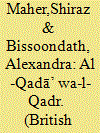

|
|
|
|
|
| Summary/Abstract |
This paper explores how the normative Islamic concepts of divine decree and predestination are used for motivational purposes in salafi-jihadi literature. These concepts are known as al-qaḍā’ wa-l-qadr within Islamic jurisprudence and assert that certain characteristics in an individual’s life—such as their lifespan, wealth and progeny—have already been preordained by God. Salafi-Jihadi groups, not least al-Qaeda and Islamic State, frame these concepts in unique and important ways to motivate their fighters on the battlefield, liberating them from fear of personal consequences. In particular, we examine the use of this concept not just to motivate fighters at a personal level, but also its role in maintaining morale during times of hardship, its ability to explain away failures and defeats, and its ability to project both momentum and success even when the facts suggest otherwise.
|
|
|
|
|
|
|
|
|
|
|
|
|
|
|
|
| 6 |
ID:
067776
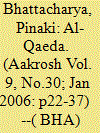

|
|
|
|
|
| Publication |
2006.
|
| Summary/Abstract |
On 5 February 2003, the then US Secretary of State, Gen Colin Powell had said at the United Nations Security Council (UNSC) that, “Iraq today harbors a deadly terrorist network, headed by Abu Musab al-Zarqawi, an associate and collaborator of Osama bin Laden and his al-Qaeda lieutenants.” This was an important part of Powell’s false case for an aggression against Iraq and its then president, Saddam Hussain. The world came to know of Zarqawi then for the first time. On 27 December 2004, Osama Bin Laden, the emir of al-Qaeda, declared Zarqawi as the emir al-Qaeda (The Base) in Iraq. Powell’s seemingly prophetic words bore fruit not when Saddam Hussain was at the helm, but when Iraq was under the occupation of the Anglo-American coalition.....
|
|
|
|
|
|
|
|
|
|
|
|
|
|
|
|
| 7 |
ID:
083818
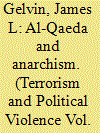

|
|
|
|
|
| Publication |
2008.
|
| Summary/Abstract |
This article situates al-Qaeda and similar jihadi movements within the category of anarchism. In so doing, it challenges the central pillar of the terrorology paradigm: the notion that terrorism is useful as an independent unit of analysis. The article takes a two-fold approach; in the first part, it offers a five-part definition of anarchism, based on the literature in the fields of history, political science, and sociology. Anarchism is distinguished by five characteristics: First, anarchism is an episodic discourse which provides its adherents with a prescription for action and which has been consistently available to, but only sometimes adopted by, political actors in the modern world. Second, anarchism makes for itself the claim of being defensive in nature. Third, anarchism is anti-systemic; i.e., the target of anarchist grievances is the very system (the nation-state system, capitalism) anarchists view as the source of oppression. Fourth, by "othering" the source of oppression, anarchists delineate, either implicitly or explicitly, an ideal counter-community. Finally, unlike the disarticulated domain of, for example, scientific socialism, the discursive field of anarchism draws heavily from the specific cultural milieu from which it springs. The second part of the article examines al-Qaeda and similar movements in terms of these five characteristics, contrasts al-Qaeda with other organizations (Hamas, Hizbullah) which have often been conflated with al-Qaeda under the terrorist rubric, and argues that, based on those characteristics, al-Qaeda does not represent a new or sui generis phenomenon, but rather fits squarely into the anarchist mold.
|
|
|
|
|
|
|
|
|
|
|
|
|
|
|
|
| 8 |
ID:
132298
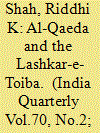

|
|
|
|
|
| Publication |
2014.
|
| Summary/Abstract |
Study of ideology is one of the most important domains of consideration for a successful counter-terrorism strategy. It is necessary to know and understand the ideology of a terrorist outfit coupled with the ongoing evolution at the same, its chief ideologues and its target audiences in order to provide an alternative ideology or in other words to win the 'hearts and the minds' of the people. This article traces the mounting similitude in the discourse and the actions of Lashkar-e-Taiba and the ideology of Al-Qaeda. The article begins with a brief depiction of the debate on the 'end of ideology' before proceeding on to an examination of Al-Qaeda's ideology. In the next section, LeT's discourse and actions from 1990 to 2010 are scrutinised followed by an analysis that attempts to draw out parallels between the ideologies of the two terrorist organisations. In the last section, the conclusion raises several pertinent points for the consideration of counter-terrorist specialists and policy makers.
|
|
|
|
|
|
|
|
|
|
|
|
|
|
|
|
| 9 |
ID:
139028
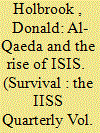

|
|
|
|
|
| Summary/Abstract |
Ayman al-Zawahiri’s leadership of al-Qaeda has been beset by a series of calamities that threaten the viability of the movement’s core group and its legacy. Zawahiri was always more suited to be second in command, offering dense strategic and ideological deliberations rather than acting as the public face of a global Islamist militant movement. Replacing the charismatic Osama bin Laden was thus always going to be a challenge. The fact that secular Arab rulers, especially in Egypt (Zawahiri’s native land and a consistent preoccupation of his), have been toppled on his watch through popular uprising and military intervention – as opposed to jihadist coercion – has further undermined Zawahiri’s position as al-Qaeda leader. The Arab Spring uprisings demonstrated the success of regime-change methods that al-Qaeda had consistently dismissed, while removing some of the main protagonists of its grievance narrative.
|
|
|
|
|
|
|
|
|
|
|
|
|
|
|
|
| 10 |
ID:
139661
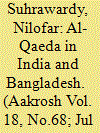

|
|
|
| 11 |
ID:
022138


|
|
|
|
|
| Publication |
Aug 2002.
|
| Description |
24-26
|
|
|
|
|
|
|
|
|
|
|
|
|
|
|
|
| 12 |
ID:
060186
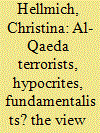

|
|
|
| 13 |
ID:
087056
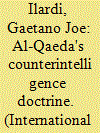

|
|
|
|
|
| Publication |
2009.
|
| Summary/Abstract |
It is up the leadership and individuals to make continuous effort to reach a perfect security image that could achieve the required target. It is up to each group to keep developing and innovating security measures that suit the development of the enemy's abilities to benefit from previous trials and renewed experiences and to be familiar with whatever is new with regards to the opposing security of the group's movement.
|
|
|
|
|
|
|
|
|
|
|
|
|
|
|
|
| 14 |
ID:
068939
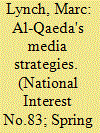

|
|
|
| 15 |
ID:
062387
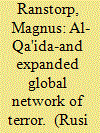

|
|
|
| 16 |
ID:
098982
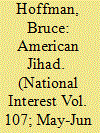

|
|
|
| 17 |
ID:
139752
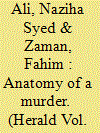

|
|
|
|
|
| Summary/Abstract |
IT was a 9mm gun, probably a Stoeger. Before Saad Aziz got this “samaan” through an associate, by his own admission, he had already plotted a murder. On the evening of Friday, April 24, 2015, he met four other young men, all well-educated like him, somewhere on Karachi’s Tariq Road to finalise and carry out the plot. As dusk deepened into night, they set off towards Defence Housing Society Phase II Extension on three motorcycles. Their destination: a café-cum-communal space – The Second Floor or T2F – where an event, Unsilencing Balochistan: take two, was under way. Their target: Sabeen Mahmud, 40, the founder and director of T2F.
|
|
|
|
|
|
|
|
|
|
|
|
|
|
|
|
| 18 |
ID:
021153
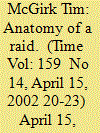

|
|
|
|
|
| Publication |
April 15, 2002.
|
| Description |
20-23
|
|
|
|
|
|
|
|
|
|
|
|
|
|
|
|
| 19 |
ID:
133705
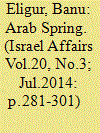

|
|
|
|
|
| Publication |
2014.
|
| Summary/Abstract |
This article argues that the 'Arab Spring' has ended the long-standing US-Israeli common strategy of supporting pro-Western and semi-secular autocracies in the Arab world. During these tumultuous events Washington chose to support the rebellions to varying degrees, thus exacerbating Israel's concerns regarding the adverse regional implications attending this shift (notably the ascendance of Islamist regimes and the diversion of world attention from Iran's nuclear quest). By way of ameliorating such threats, the US needs to pursue a policy of supporting pro-democracy groups in the region while formulating a clear policy to deal with the threats from Iran and radical Islamist groups. All in all, the 'Arab Spring' has created a highly volatile strategic environment thus making Israel an even more valuable strategic ally for the US
|
|
|
|
|
|
|
|
|
|
|
|
|
|
|
|
| 20 |
ID:
139351
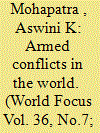

|
|
|
|
|
| Summary/Abstract |
To sum up, what accounts for the rising incidence of internal armed conflicts in plural societies is the interplay of variety of factors ranging from the nature of the polity (i.e. liberal/transitional democratic or autocratic), stage of economic development, level of integration and state-society engagement to the process of state formation and national identity construction.
|
|
|
|
|
|
|
|
|
|
|
|
|
|
|
|
|
|
|
|
|